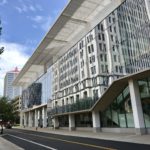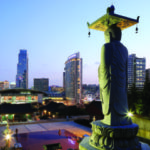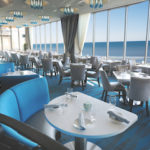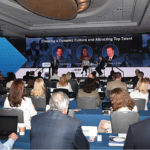
Soaring a quarter mile into the air, the Petronas Twin Towers building in Kuala Lumpur, Malaysia, is one of the most iconic structures in Southeast Asia. Connecting the towers midway up, the Skybridge offers staggering views overlooking the Kuala Lumpur Convention Centre campus and the entire Kuala Lumpur City Centre (KLCC) district, which is designed as a fully integrated city-within-a-city. From that vantage, it’s easy to understand why the Malaysian capital is so convenient for large conventions. There are more than 7,000 upscale, branded hotel rooms within a 10-minute walk of the convention center, and as many more within a 10-minute drive. There are also a handful of well-known luxury hospitality chains opening hotels in the district during the next 18 months, with rates less than in many other international destinations in Southeast Asia, providing an especially attractive value for association planners.
Malaysia is primarily a mix of Chinese, Muslim, and Indian influences, among many other cultures, all of them mingling peacefully. That makes the country a perfect gateway into Asian culture for people who want to experience a little taste of everything that the continent has to offer — as I found during a recent trip hosted by the Malaysian Convention & Exhibition Bureau (MyCEB).
DAY 1 Our group of U.S. meeting planners and media flew to Malaysia via Abu Dhabi aboard Etihad Airlines. We arrived in time for dinner at the 561-room JW Marriott Kuala Lumpur in the central business district, about a 15-minute shuttle to the Kuala Lumpur Convention Centre. The JW Marriott and neighboring Ritz-Carlton, Kuala Lumpur anchor the Bukit Bintang entertainment district, where the streets are busy with locals and visitors alike until late at night.
We enjoyed our first meal in Malaysia at JW Marriott’s Feast Village, which encompasses more than a dozen themed restaurants that can be combined for groups of up to 500 people. We were surrounded by Shanghainese dim sum, Korean barbecue, Indian tandoori, Spanish tapas, and many other cuisines. “We are well known around the world for our multicultural cuisine, because Malaysia itself is such a diverse collection of cultures,” Ho Yoke Ping, MyCEB’s general manager of business events, said during dinner. “I think that is representative of the welcoming and inclusive nature of the Malaysian people in general.”
DAY 2 Looking down from the Petronas Towers’ Skybridge, we could see the new Four Seasons Hotel Kuala Lumpur under construction next door. Attached on the other side, the Mandarin Oriental, Kuala Lumpur leads directly into the convention center. Together, the properties create a semi-circle that wraps around a 40-acre park with walking trails connecting the venues and the luxury shopping center at the base of the Petronas Towers.
Directly behind the convention center, the Grand Hyatt Kuala Lumpur is a chic, modern property with 370 rooms, 42 suites, and 35,500 square feet of dedicated meeting space. The THIRTY8 restaurant on the 38th floor is wrapped in glass on all sides, with a series of demonstration kitchen stations in the middle.
A highlight of the trip was the Royal Selangor factory and museum. The world’s largest pewter-production facility, Royal Selangor was founded in 1885 and today is filled with gorgeous displays of exquisite pewter craftsmanship ranging from delicate teakettles to large contemporary sculptures. The venue also offers team-building events where everyone creates their own pewter artwork.
DAY 3 I had one of my favorite meals in Malaysia during the third day of the trip — a buffet lunch at the Shangri-La Hotel Kuala Lumpur, featuring a variety of delicious international cuisines, presented in a glass-enclosed space facing the Shangri-La’s oasis-like backyard. A five-minute drive from the convention center, the hotel features the 16,250-square-foot Grand Ballroom and 662 guest rooms, including 101 suites.
From the convention center, it was about a 20-minute drive to the 503-room Hilton Kuala Lumpur, located beyond the downtown core, near KL Sentral train station. The thoroughly modern Hilton is part of a growing and fashionable mixed-use development as well as a complete, self-contained meeting experience in its own right, with a 13,000-square-foot ballroom, 10 well-executed restaurants, and a trendy mix of public spaces with great views overlooking the city.
Nearby, The Majestic Hotel Kuala Lumpur is a well-preserved British Colonial–style masterpiece that made a big impact on our entire group. Since opening in 1932, the original 51-room property has hosted world leaders and gala events for up to 400 people. Today, its reconfigured 47 suites have been completely updated with an Art Nouveau design, and a newer Tower Wing offers 253 guest rooms and suites with polished marble and chrome embellishments.
DAY 4 A one-hour flight from Kuala Lumpur, the island of Penang became the first British trading post in the Far East around 1885, when wealthy merchants conducted business at the waterfront Eastern & Oriental Hotel. The original 100 suites in the E&O’s Heritage Wing are classical in their interior design, surrounding the property’s seaside pool and elegant Farquhar’s Bar. The 128 rooms in the Victory Wing, built in 2013, are more modern, but they retain the same design accents such as dark hardwood floors, intricate white moldings, and pedestal tubs. For events, the E&O’s 300-foot waterfront terrace is sublime for day or night receptions with the pervading sea breezes, while indoors, its ballroom seats 400 people.
Spreading out from the E&O, George Town is a UNESCO World Heritage City filled with intriguing shops and restaurants seeded among the historic Malaysian shophouses lining the narrow streets. We met with representatives from Penang Tourism at the fashionable 208-room G Hotel Kelawai, located between George Town and the airport. The G Hotel’s rooftop pool and minimalist design — constructed mostly from organic materials — are popular with the technology and pharma industries, both of which are well-established in Penang.
In one of G Hotel Kelawai’s board rooms, Tourism Penang rolled out an impressive presentation on the new SPICE Convention Centre, opening in 2018. The building will be part of a larger integrated district that encompasses a professional sports arena, an aquatic facility, and a new, 450-room hotel. SPICE will have a 45,000-square-foot, pillar-free ballroom, 15 flexible meeting rooms, and a seven-acre landscaped roof garden.
DAY 5 For our final evening, we gathered at the Kuala Lumpur Convention Centre, which offers a variety of flexible spaces and modern infrastructure — including 132,000 square feet of exhibition space, a 3,000-person Plenary Hall with two levels of tiered seating, a Grand Ballroom that can accommodate a 2,000-person banquet, and 20 meeting and breakout rooms.
All of the center’s four levels have floor-to-ceiling windows facing the Petronas Towers, which look especially spectacular at night. The center’s chefs prepared an amazing feast of local dishes, including Kampung seafood soup served in batu lesung (a mortar and pestle), ayam percik (coconut-spiced chicken), rendang tok (beef stewed in herbs and spices), Oriental-braised duck, nasi kerabu (made with blue-colored rice), and many others.
Malaysia climbed five places, to 30, in the International Congress and Convention Association’s 2014 global rankings, which Alan Pryor, the center’s general manager, attributes to the growing awareness of the KLCC district among international groups. The 1,759 events that the center hosted last year represent an 11-percent increase over the previous record of 1,565 in 2013 — and a new attached building scheduled for completion in 2018 will add another 110,000 square feet to the 250,000-square-foot facility.
“This is a testament to the center’s capability to successfully host large-scale, high-profile events,” Pryor said, “and it reinforces our reputation as Malaysia’s premier convention facility and a leading meetings venue in Asia-Pacific.”



